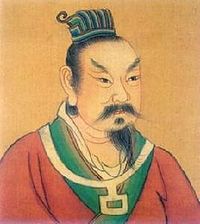Zhu Quanzhong
| Zhu Wen | |||||||||||||
|---|---|---|---|---|---|---|---|---|---|---|---|---|---|
 |
|||||||||||||
| Reign | June 1, 907 – July 18, 912 | ||||||||||||
| Born | December 5, 852 | ||||||||||||
| Died | July 18, 912 | ||||||||||||
|
|||||||||||||
| Dynasty | Later Liang | ||||||||||||
| Full name | |
|---|---|
|
|
| Posthumous name | |
| Emperor Shénwǔ Yuánshèng Xiào (神武元聖孝皇帝) |
|
| Temple name | |
| Tàizǔ (太祖) |
Emperor Taizu of Later Liang (後梁太祖), personal name Zhu Quanzhong (朱全忠) (852–912), né Zhu Wen (朱溫), name later changed to Zhu Huang (朱晃), nickname Zhu San (朱三, literally, "the third Zhu"), was a Jiedushi (military governor) at the end of the Chinese dynasty Tang Dynasty, who previously served as a general under the rival Emperor Huang Chao's Empire of Qi and overthrew Empire of Tang in 907, established the Later Liang as its emperor, and ushered in the era of the Five Dynasties and Ten Kingdoms.
Zhu was able to conquer much of central China, but most of Shaanxi, Shanxi, and Hebei remained outside his reach, controlled by rival states Qi, Jin, and Yan respectively. Most of his later campaigns were directed at the Shatuo-ruled Jin state (later to become the Later Tang) based in Shanxi, but they mostly ended in failure due to the resourcefulness of the Jin leaders, first under Li Keyong and then later under his son, Li Cunxu. Due to his emphasis on unifying the north Taizu was not able to make any inroads into the south, which came to be controlled by about a dozen different states over the next few decades during the Five Dynasties and Ten Kingdoms period. The rulers in the south largely were nominally submissive to him with the exception of major states Wu and Former Shu.
...
Wikipedia
